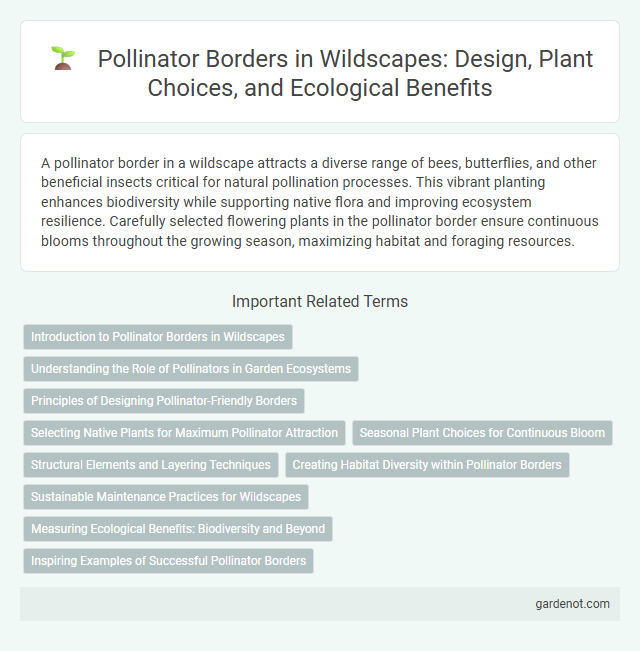A pollinator border in a wildscape attracts a diverse range of bees, butterflies, and other beneficial insects critical for natural pollination processes. This vibrant planting enhances biodiversity while supporting native flora and improving ecosystem resilience. Carefully selected flowering plants in the pollinator border ensure continuous blooms throughout the growing season, maximizing habitat and foraging resources.
Introduction to Pollinator Borders in Wildscapes
Pollinator borders in wildscapes create vital habitats that support bees, butterflies, and other pollinating insects crucial for ecosystem health and biodiversity. These borders typically feature a diverse mix of native flowering plants that bloom throughout the growing season, ensuring continuous nectar and pollen sources. Establishing pollinator borders enhances pollination services, promotes wildlife corridors, and contributes to the sustainability of agricultural landscapes.
Understanding the Role of Pollinators in Garden Ecosystems
Pollinators, including bees, butterflies, and hoverflies, play a crucial role in Wildscape pollinator borders by facilitating the reproduction of flowering plants, which supports biodiversity and ecosystem health. These insects enable the transfer of pollen, enhancing fruit and seed production essential for plant propagation and sustaining local wildlife populations. Implementing diverse, native plant species in pollinator borders optimizes habitat suitability and food resources, ensuring robust pollinator activity and thriving garden ecosystems.
Principles of Designing Pollinator-Friendly Borders
Designing pollinator-friendly borders requires selecting a diverse range of native flowering plants that bloom sequentially to provide continuous nectar and pollen sources throughout the growing season. Incorporating varied plant heights and structural diversity creates accessible habitats for different pollinator species such as bees, butterflies, and hoverflies. Avoiding pesticides and ensuring proximity to water sources further enhances the ecological functionality and sustainability of pollinator borders within wildscape gardens.
Selecting Native Plants for Maximum Pollinator Attraction
Selecting native plants such as Echinacea, Asclepias, and Monarda enhances pollinator attraction by providing familiar nectar and pollen sources crucial for local bees, butterflies, and hummingbirds. Native species adapt seamlessly to regional soil and climate conditions, ensuring robust blooms that consistently support pollinator populations. Incorporating a diverse array of flowering plants with staggered bloom times maximizes habitat availability and sustains pollinator health throughout the growing season.
Seasonal Plant Choices for Continuous Bloom
Seasonal plant choices in a wildscape pollinator border ensure continuous bloom from early spring through late fall, supporting diverse pollinator species year-round. Early bloomers like crocus and snowdrops provide vital nectar in spring, while summer staples such as coneflowers, bee balm, and black-eyed Susans offer abundant pollen and nectar. Late-season bloomers like goldenrod and asters sustain pollinators preparing for winter, maintaining a thriving ecosystem across seasons.
Structural Elements and Layering Techniques
The Pollinator Border in Wildscape employs structural elements such as varied plant heights and dense foliage to create microhabitats that support diverse pollinator species. Layering techniques involve strategic placement of groundcovers, mid-height perennials, and taller flowering shrubs to maximize nectar availability throughout the growing season. These design principles enhance habitat complexity, improving pollinator foraging efficiency and shelter opportunities.
Creating Habitat Diversity within Pollinator Borders
Creating habitat diversity within pollinator borders enhances ecosystem resilience by attracting a wide range of pollinator species such as bees, butterflies, and hoverflies. Incorporating native flowering plants with varied bloom times and structural features supports continuous foraging and nesting opportunities throughout the seasons. Strategic layering of ground cover, shrubs, and flowering perennials promotes increased biodiversity, contributing to the overall health of Wildscape environments.
Sustainable Maintenance Practices for Wildscapes
Pollinator borders in wildscapes thrive through sustainable maintenance practices such as minimal mowing, selective weeding, and seasonal plant monitoring to preserve native flora and support pollinator diversity. Integrating organic mulching and avoiding synthetic pesticides enhances soil health and fosters resilient habitats for bees, butterflies, and other pollinators. These methods contribute to biodiversity conservation and long-term ecological balance within wildscape ecosystems.
Measuring Ecological Benefits: Biodiversity and Beyond
Pollinator borders in Wildscape significantly enhance biodiversity by providing essential habitats for native pollinators such as bees, butterflies, and hoverflies, boosting ecosystem resilience. Measuring ecological benefits involves monitoring species richness, pollinator activity, and plant reproductive success to gauge habitat effectiveness. These assessments reveal improvements in ecosystem services, including increased pollination rates and support for adjacent agricultural productivity.
Inspiring Examples of Successful Pollinator Borders
Inspiring examples of successful pollinator borders include the use of native wildflowers such as Echinacea, Monarda, and Asclepias, which attract diverse pollinators like bees, butterflies, and hummingbirds. Strategic layering of plants with staggered bloom times ensures continuous nectar sources from early spring to late fall, enhancing pollinator visitation rates. Integration of habitat features such as bare ground patches and shallow water sources further supports nesting and hydration needs, promoting a thriving pollinator ecosystem.
Pollinator border Infographic

 gardenot.com
gardenot.com